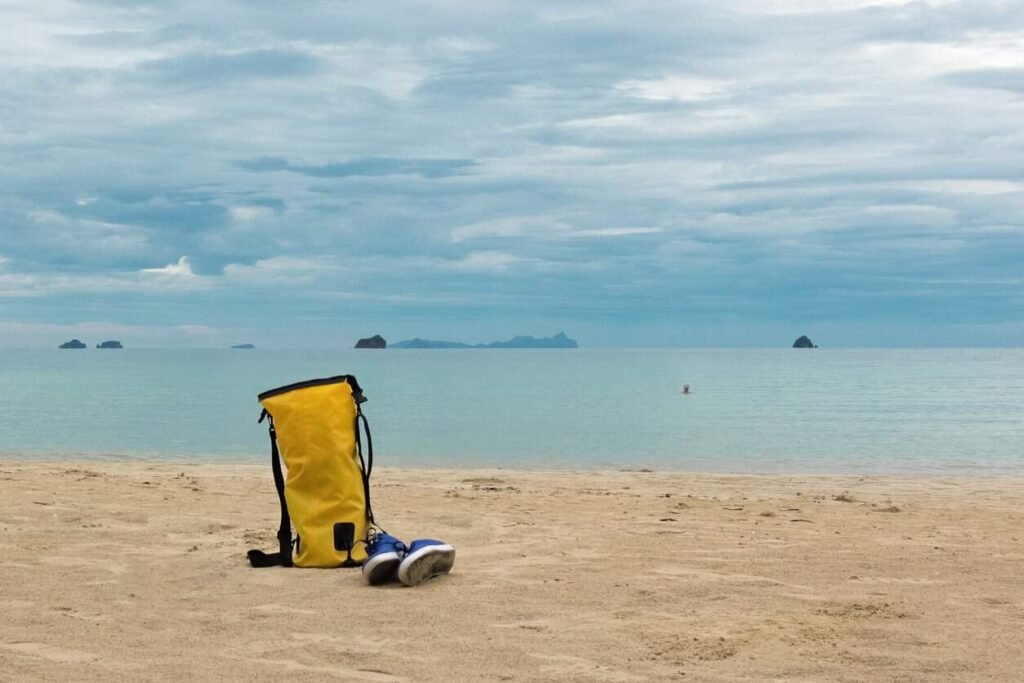
For swimmers and water adventurers, the question of whether you can swim with a dry bag is pertinent. In this exploration, we dive into the feasibility and practicality of swimming with a dry bag, ensuring your belongings stay safe and dry.
Design and Buoyancy of Dry Bags
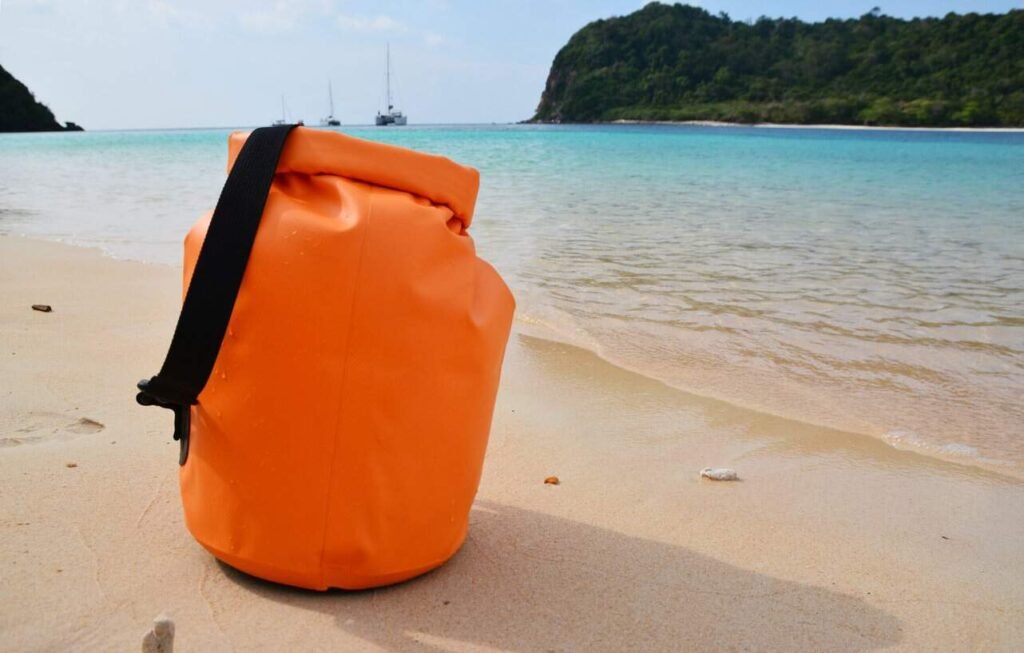
Material Composition and Waterproofing
Dry bags are typically made from materials like PVC or Nylon, which offer excellent waterproofing capabilities. These materials are chosen for their ability to create an impermeable barrier, ensuring no water seeps in to damage your belongings.
Sealing Mechanism and Water Tightness
The sealing mechanism, often a roll-top closure secured with a buckle or strap, is critical in ensuring the bag’s water tightness. This design allows for an adjustable seal, making the bag virtually impenetrable by water when closed correctly.
Buoyancy and Floatation Capabilities
Buoyancy is a key feature of dry bags, allowing them to float on water when sealed with air trapped inside. This characteristic is particularly useful for swimmers, as it enables the bag to be used as a flotation aid and visibility marker.
Durability Against Environmental Factors
Durability is paramount, especially when using dry bags in open water. Materials like PVC and heavy-duty Nylon are resistant to UV rays, saltwater, and abrasions, ensuring the bag withstands various environmental challenges.
Design Variations for Different Needs
Dry bags come in various designs and sizes, catering to different needs. From compact bags for minimal essentials to larger ones for extensive gear, the design also incorporates features like transparent windows for visibility of contents and D-rings for easy attachment.
Practical Tips for Swimming with a Dry Bag
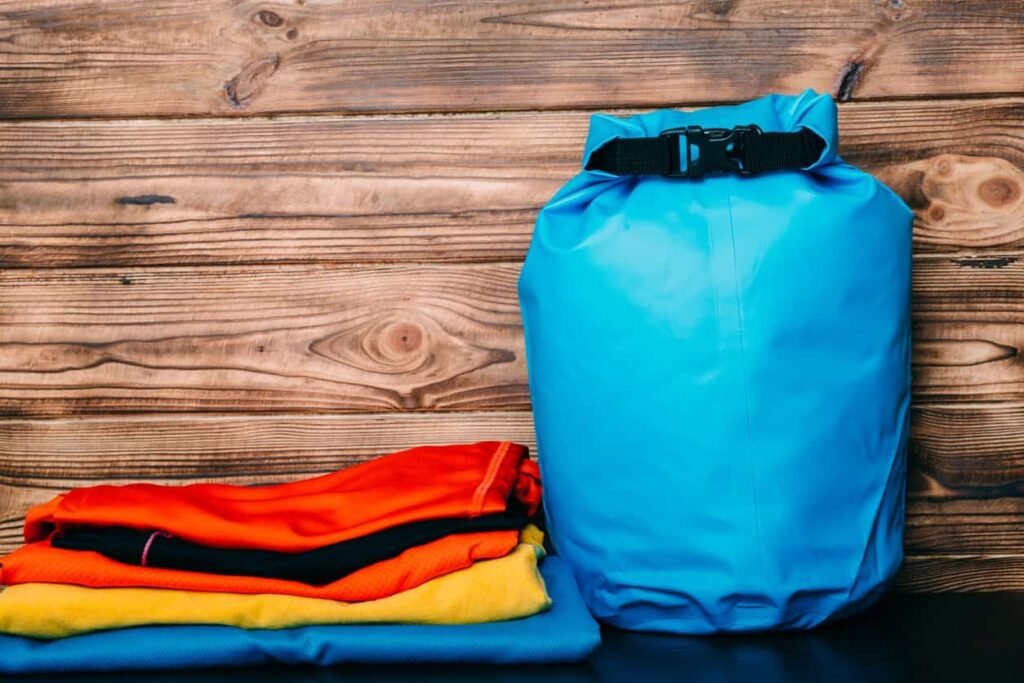
Ensuring Proper Seal for Waterproofing
The effectiveness of a dry bag in water largely depends on how well it’s sealed. Ensure the bag is sealed correctly – typically through a roll-top closure. Rolling it down tightly and securing it with the buckle prevents any water from entering the bag.
Correct Attachment to the Body
Securely attaching the dry bag to your body is crucial for swimming. Use straps or a tether to attach the bag to your waist or across your back. Ensure the attachment is snug but comfortable, allowing free movement while swimming.
Balancing the Weight Inside the Bag
Even distribution of weight within the bag is essential. Balance heavier items with lighter ones to maintain the bag’s buoyancy and stability in water. Avoid overloading the bag, as it can become cumbersome and affect its floatation.
Testing Buoyancy Before Swimming
Before entering the water, it’s important to test the bag’s buoyancy. Place the sealed bag in shallow water to ensure it floats and the seal holds. This test can prevent any surprises during your swim.
Visibility and Safety Precautions
Opt for brightly colored dry bags to enhance visibility in the water. This is especially important in open water or busy swimming areas, where being seen by other water users is crucial for safety.
Awareness of Environmental Conditions
Be mindful of the swimming environment – currents, tides, and weather conditions can affect your experience with a dry bag. Understanding these factors can help you adjust your swimming technique and bag attachment accordingly.
Safety Considerations and Best Practices
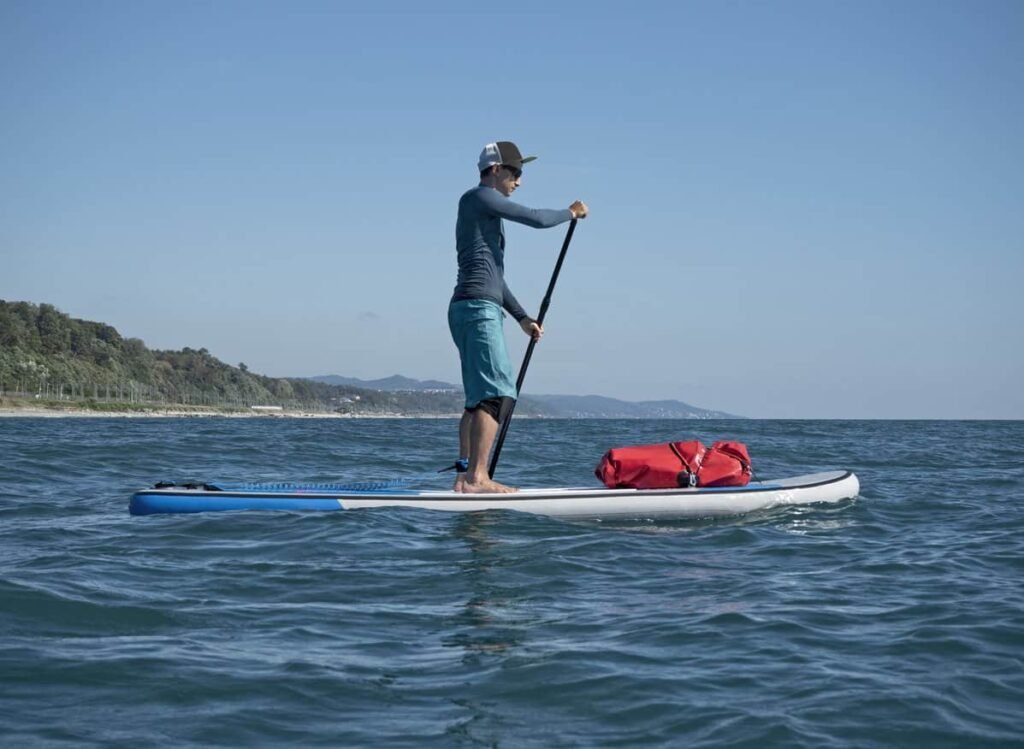
Using Dry Bags as an Emergency Floatation Device
While dry bags can provide some buoyancy, it’s important to note that they are not designed as primary flotation devices. They should be used as a supplemental floatation aid only. Swimmers should still rely on their swimming skills and, if necessary, proper life vests or floatation devices.
Visibility for Swimmers and Other Water Users
Swimmers should choose brightly colored dry bags to enhance their visibility in the water. This is crucial in areas shared with boats, jet skis, and other watercraft to prevent collisions and ensure you are easily spotted by rescuers in case of an emergency.
Practicing with the Dry Bag
Before venturing into open waters, practice swimming with the dry bag in a controlled environment, like a swimming pool or a calm beach area. This practice helps you get accustomed to the bag’s weight and feel in the water, ensuring you are comfortable and efficient in your swimming technique.
The Role of Dry Bags in Water-Based Activities
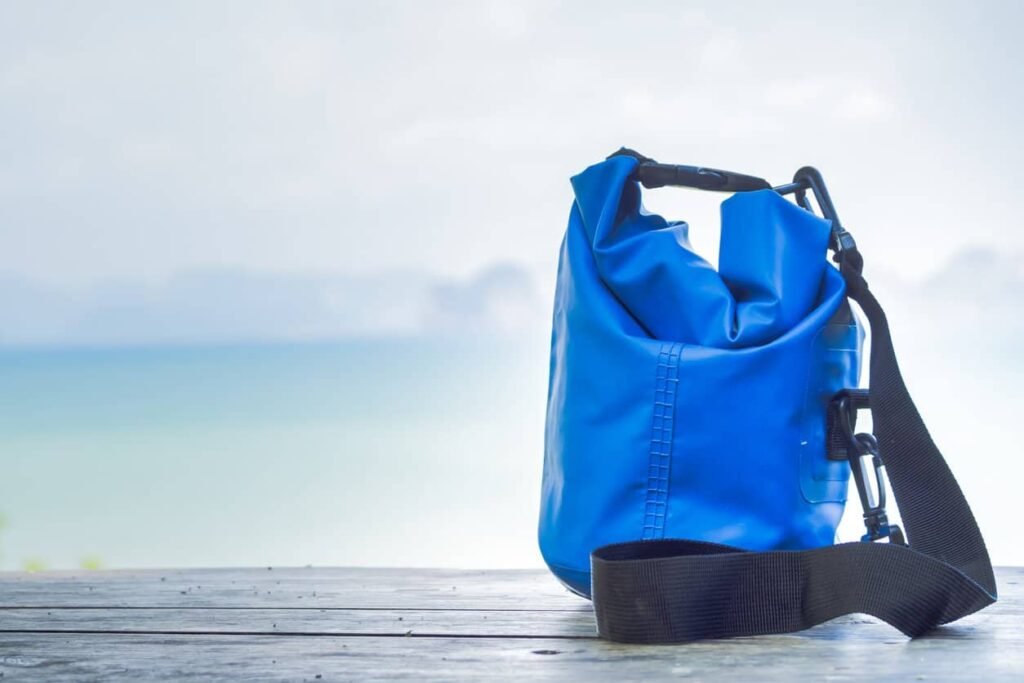
Kayaking and Canoeing
In kayaking and canoeing, dry bags protect essentials like food, clothing, and emergency gear from getting wet. They can be securely attached to the kayak or canoe, ensuring your belongings stay dry even if you capsize or encounter rough waters.
Stand-Up Paddleboarding (SUP)
For SUP enthusiasts, dry bags offer a convenient way to carry items such as sunscreen, snacks, and cameras. They can be easily attached to the board, providing a secure and waterproof storage solution while paddling.
Fishing Expeditions
During fishing trips, whether from the shore or a boat, dry bags keep gear like electronics, bait, and personal items safe and dry. Their durability and waterproof nature make them an essential item for any fishing expedition.
Sailing and Boating
On sailing or boating trips, dry bags protect valuables from sea spray and accidental immersions. Larger dry bags can store items like spare clothes and blankets, while smaller ones can keep personal items like wallets and phones dry.
Snorkeling and Diving
For snorkeling and diving adventures, dry bags offer a way to keep items like towels, change of clothes, and snacks dry on the boat or shore. Some dry bags are also designed to float, so they can be towed along while snorkeling.
Benefits of Dry Bags in Enhancing Swimming Experience
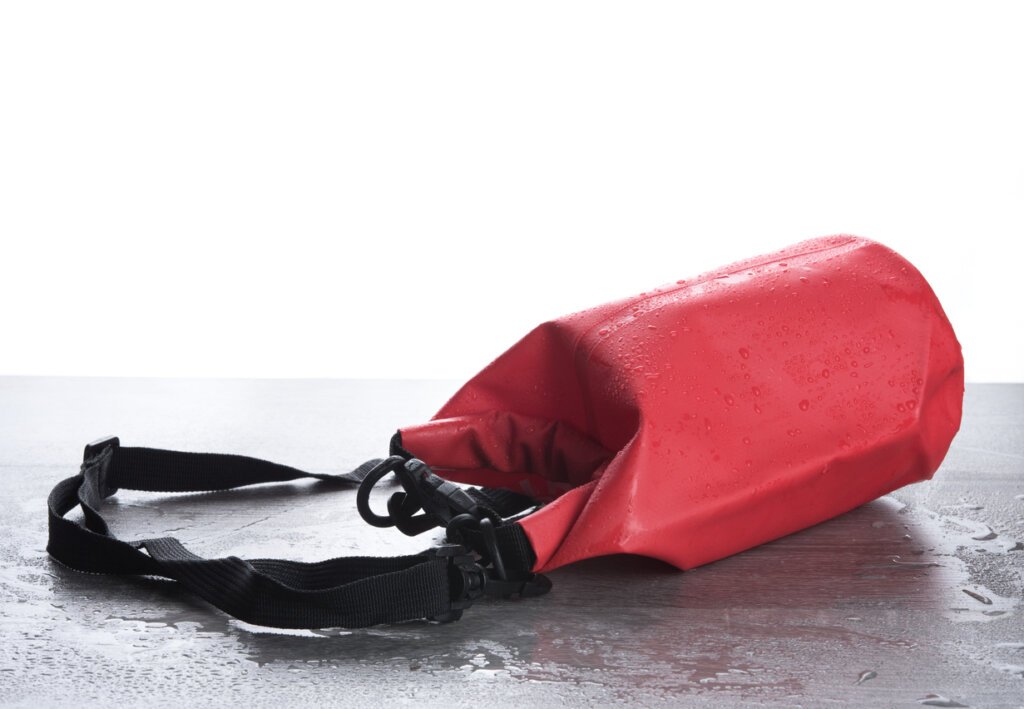
Increased Visibility in Open Water
For safety in open water, visibility is crucial. Brightly colored dry bags make swimmers more visible to boats, jet skis, and other swimmers, reducing the risk of accidents.
Buoyancy Aid for Resting
Dry bags can provide a buoyancy aid for swimmers to rest or adjust goggles. While not a substitute for a life jacket, the buoyancy can offer a momentary respite during long swims.
Convenience for Transporting Swim Gear
Dry bags allow swimmers to conveniently transport their swim gear to and from their swimming location. The ability to carry everything in one waterproof bag simplifies the process and keeps gear organized.
Ease of Access to Hydration and Nutrition
For longer swims, having easy access to hydration and nutrition is important. Dry bags can store snacks and water bottles, allowing swimmers to refuel without returning to shore.
Flexible Storage Options for Various Needs
Dry bags come in different sizes and designs, offering flexible storage options to meet the specific needs of swimmers. Whether it’s a short training session or a long-distance swim, there’s a dry bag that fits the requirement.
Limitations and Considerations When Using Dry Bags for Swimming
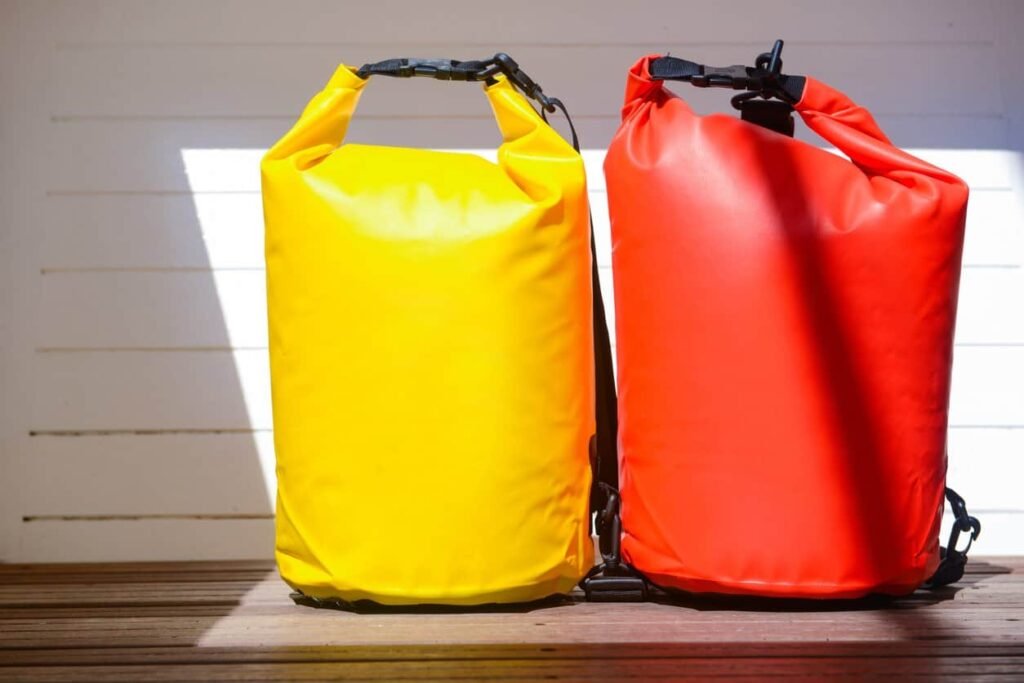
Not a Substitute for Swimming Skills
Dry bags should not be used as a crutch for inadequate swimming skills. They are an aid, not a lifesaver. Swimmers should ensure they have the necessary swimming ability and endurance before relying on a dry bag in open waters.
Weight and Maneuverability in Water
The weight of a packed dry bag can affect your swimming speed and maneuverability. Overpacking can make the bag heavy and cumbersome, impacting your swimming technique and causing fatigue more quickly.
Impact on Swimming Form and Technique
Swimming with a dry bag, especially one that is tethered to you, can alter your swimming form and technique. It’s important to practice and adjust your stroke to accommodate the additional drag and weight.
Water Resistance and Drag
While dry bags are designed to be water-resistant, they can create drag in the water, affecting your swimming efficiency. Choosing the right size and shape of the bag can help minimize this impact.
Durability in Saltwater and Chlorinated Environments
Exposure to saltwater and chlorine can affect the durability of dry bags over time. Regular rinsing and proper maintenance are necessary to prolong their lifespan in these environments.
Storage Capacity Limitations
Dry bags have a finite storage capacity. Swimmers need to be mindful of the bag’s size limitations and pack only the essentials. Overloading can compromise the bag’s waterproof integrity and buoyancy.

FAQ
Q1:Can dry bags completely prevent water from entering?
A:While dry bags are designed to be highly water-resistant, it’s important to seal them correctly to prevent water entry. However, under certain conditions like prolonged submersion, some water ingress may occur.
Q2:Are all dry bags buoyant?
A:Most dry bags are buoyant when sealed with air inside. The buoyancy level depends on the bag’s size and how much gear is packed inside. It’s important to test the buoyancy before relying on it for swimming.
Q3:Can I use any type of dry bag for swimming?
A:While most dry bags can be used for swimming, lightweight and brightly colored bags are recommended for better visibility and ease of swimming. It’s also important to consider the bag’s size and attachment method.
Q4:How do I maintain my dry bag after swimming?
A:Rinse your dry bag with fresh water after swimming, especially if used in saltwater or chlorinated pools. Dry it thoroughly before storing to prevent mildew and material degradation.
Q5:How much gear can I carry in my dry bag while swimming?
A:This depends on the size of your dry bag. However, for swimming, it’s advisable to carry only essentials to maintain buoyancy and reduce drag.
Q6:Is it safe to swim with a dry bag in open waters?
A:Swimming with a dry bag in open waters can be safe if you are a competent swimmer and aware of your surroundings. The dry bag should be used as an aid, not a lifesaving device, and proper safety precautions should be followed.
Conclusion
In summary, swimming with a dry bag is not only feasible but also brings several benefits, from protecting personal items to enhancing safety through buoyancy and visibility. However, it’s crucial to choose the right bag, pack it correctly, and understand its limitations. With proper use and safety precautions, a dry bag can be a valuable companion for swimmers, enriching their experience in the water.

